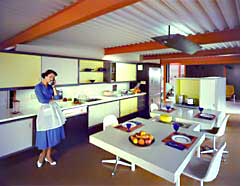Eichler X-100, House of Steel
 As we look back over the 20th century and the nearly 11,000 single-family dwellings built by Eichler Homes and its contingent of architects, one house stands out from the rest—the X-100. It was listed to the National Register of Historic Places in 2016.
As we look back over the 20th century and the nearly 11,000 single-family dwellings built by Eichler Homes and its contingent of architects, one house stands out from the rest—the X-100. It was listed to the National Register of Historic Places in 2016.
Sounding more like a title from a sci-fi movie, the X-100 was designed in 1955 and opened to the public in October 1956. Its name, however, may have been derived from the X-15, a manned-space project, actually a precursor to the space shuttle, that explored ballistic flight and winged reentry, starting in 1954.
The X-100 had another similarity to the X-15, in that it was also an experimental craft, in a sense. However, it was built on a then-remote street in the rolling hills of San Mateo to explore the possibility of rigid steel homebuilding and design concepts that incorporated revolutionary twists on existing methods, products, and materials.
The grand-opening brochure for the X-100 called it "an exciting exploration into future living." And a "Wall Street Journal" article touted, "The thousands of Californians who crowded into this 'home of tomorrow' this week gaped at such innovations as a revolving fireplace, one entire wall of glass, a plastic skylight like a bomber bubble, two indoor gardens, electrically operated sliding doors that replace all windows, and steel-frame construction to eliminate the need for load bearing walls."
 This one-of-a-kind show home was never meant to be a production house. Instead, it had a two-fold purpose. First, the X-100 served as a promotional tool.
This one-of-a-kind show home was never meant to be a production house. Instead, it had a two-fold purpose. First, the X-100 served as a promotional tool.
"It was a subdivision we were having trouble marketing because of its location, which was hard to reach by the old two-lane Skyline Highway," claimed Edward 'Ned' Eichler, who at the time was only two years out of the Army and already serving as marketing manager to his father Joe's homebuilding business. "That's when I learned the difference between a pretty location, which this was, and a convenient location."
But the X-100 turned out to be a promotional bonanza. Articles filled local newspapers, and pictorials, some in full color, appeared in national magazines like "Sunset," "Living for Young Homemakers," and "Arts & Architecture." The X-100 was said to have attracted over 150,000 visitors to the 700-house Highlands development over time, as colorful signs along the roadway beckoned potential buyers to not only take a peek at the experimental home, but also stop by the three conventional Eichler models alongside.
The second reason Ned Eichler gave for building the X-100 was a little more romantic—that perhaps something new might develop out of this steel wonder which would prove useful for the homebuilding industry. "This was a time when there was a lot of talk about technology making revolutionary changes in homebuilding," stated Eichler, who admitted he and his father were skeptical, but they decided to give it a try anyway.
"I thought we could get all those manufacturers who were hanging around our business trying to get us to use their products, and talk to them about a place to try out their advanced prototypes that weren't in production yet," he explained.
So they ended up stocking the X-100 with appliances like Waste King's super-hush pulverator (garbage disposal), a jet-black automatic dishwasher that was said to contain a "new component" with five years of research behind it, and a handy-dandy NuTone five-in-one motor unit, built directly into the countertop, for grinding, mixing, blending, sharpening, or making juice at the touch of a button.

The test house also sported innovative rooftop spotlights that shone into rooms through skylights, eliminating the need for interior lamps; reversible kitchen cabinet doors (white on one side, yellow on the other) for color scheme changes; and finally, the pièce de résistance, an 8x4-foot Formica table in the kitchen that parted in the middle to reveal two-burners for keeping food toasty warm during family gatherings.
But beyond all this fluff was the structure itself. "Our architect, A. Quincy Jones, was the one who wanted to give steel another try," stated Ned Eichler. The X-100 was actually among the last of a series of five steel homes designed (using both light- and heavy-gauge steel) by the renowned Southern California architectural firm of Jones & Emmons, who was also responsible for such buildings as the University of Southern California's Annenberg School of Communications and the U.S. Embassy in Singapore.




